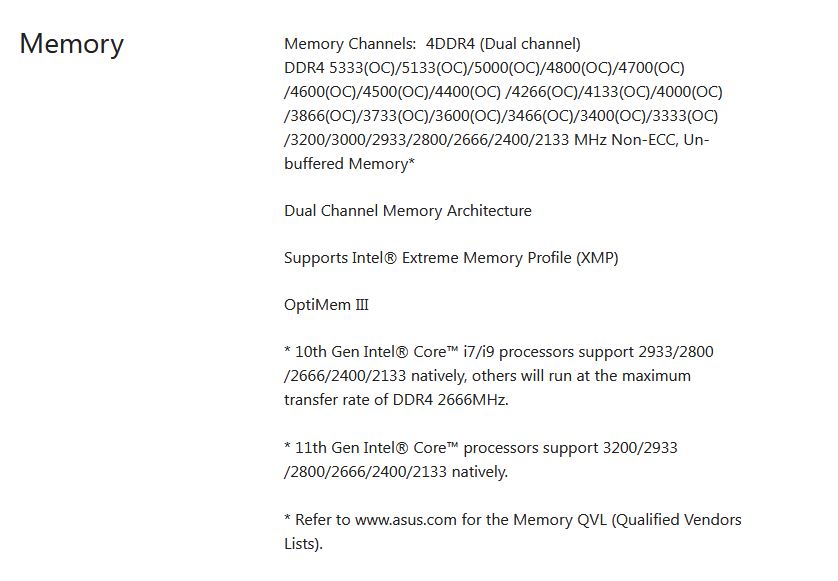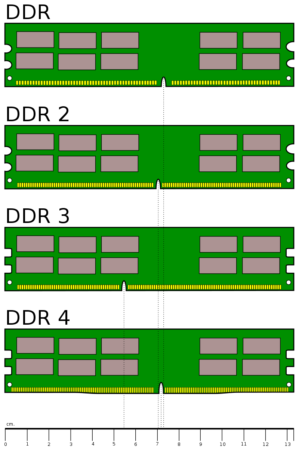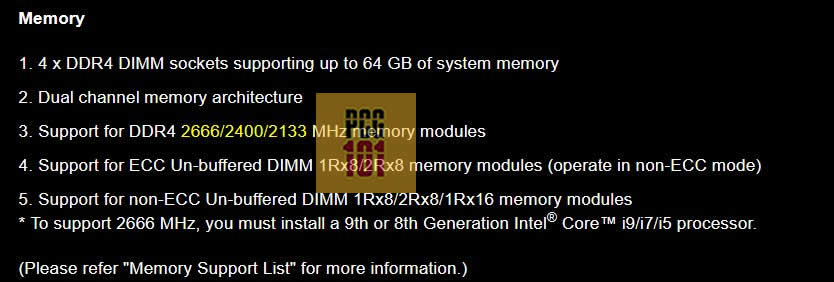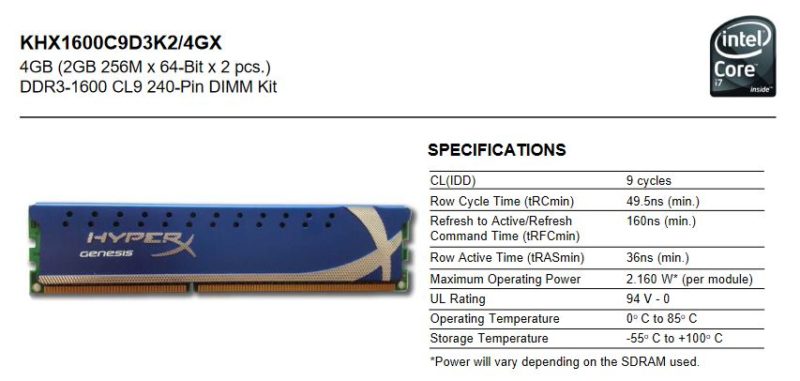The easiest way to tell whether a particular RAM stick will work with your motherboard is to look at the specifications. This should give you details regarding the type, amount, and RAM characteristics the motherboard can support.
Regarding the RAM type, i.e., DDR 2, DDR 3, and DDR 4, a motherboard is NOT backward compatible. You cannot install DDR4 RAM on a motherboard that supports DDR3 RAM and vice versa.
However, regarding the frequency and CAS latency, the RAM sticks ARE backward compatible. A DDR4 RAM stick with a frequency of 3200 MHz CAN work on a motherboard designed to support a max frequency of 3000 MHz.
The following text will examine different ways to tell if a RAM will work with your motherboard.
We will also talk about how to understand the specifications of the RAM stick you have.
TABLE OF CONTENTS
How to Tell If a RAM Will Work With Your Motherboard?
There are two critical points to consider when figuring out whether the RAM stick will work with your motherboard.
- Figuring out the memory specifications of your motherboard
- Identifying the RAM STICK specifications
1. Figuring Out the Memory Specifications of Your Motherboard
In the motherboard specifications, there is a plethora of information that you can find regarding the RAM that it can support.
Head over to the specification for your motherboard online. You will find something similar to the following:

The motherboard above is a premium motherboard featuring a high-end Intel Z590 chipset. It can support DDR4 RAM sticks with super-overclocked frequencies of up to 5333 MHz.
Now your motherboard may not have the exact specifications. But generally, you can expect to find the following information from the motherboard technical specs:
- Type of RAM it supports
- The amount of RAM it can support
- The frequency of the RAM it can support
- Whether it can keep ECC memory or not
1. Type of RAM
The latest motherboards at the moment support DDR5 RAM. However, DDR4 is still the most common type out there. DDR stands for Double Data Rate, essentially a high-bandwidth kind of RAM.
The DDR4 version was released back in 2014. However, it became widespread starting in 2016 and onwards.
If you are using an older system, there is a high chance that your motherboard would support the older DDR3 or even DDR2 version.
Hence, checking the type of RAM is the first step in determining whether a RAM stick will work on your motherboard.
DDR is not Cross Compatible – Generations have Different Physical Profiles
As mentioned earlier, the DDR RAM generations are NOT backward compatible. This is because every generation of DDR RAM has a different circuit design, signaling voltage, and even physical profile.

You can use the physical notches to determine what RAM stick you have.
Can You Install a DDR3 RAM on a DDR4 Motherboard?
The answer is no because RAM types are not backward compatible.
Obsolete RAM Types are More Expensive
Common logic will entail that a slower and older RAM would cost you less. However, that is hardly the case.
This has more to do with the supply and demand factor. Older RAMs such as DDR2 or DDR1 are harder to find. As such, they are also more expensive.
If you have an older motherboard compatible with DDR2, procuring a DDR2 stick would be more expensive than acquiring a newer DDR4 RAM stick of the same capacity.
Also Read: Why is a Motherboard Important?
2. Amount of RAM Supported by Your Motherboard – TOTAL AND PER SLOT
Another essential characteristic is the amount of RAM your motherboard can support.
You can expect to find the following max support in the current market.
- 64 GB DDR4 on budget motherboards, i.e., Intel H series
- 128 GB DDR4 on high-end motherboards, i.e., Intel Z series
- 256 GB DDR4 on workstation motherboards, i.e., AMD TRX40 series
If you have an older budget motherboard, there are chances that it could only have max support for 32 GB RAM.
Maximum RAM per Slot
While most builds do not come close to utilizing even the 64 GB RAM on budget motherboards, the total amount is worth noting because it TELLS YOU THE MAX SIZE OF THE RAM STICK EACH SLOT CAN SUPPORT.
So, for instance, if your motherboard supports 64 GB of RAM across four slots, that translates to a max amount of 16 GB per slot.
Also Read: Which Motherboards Support DDR5 RAM?
3. Determining the Frequency of the RAM Supported
The final critical RAM characteristic you can determine from the motherboard is the clock speed it can support.
Each generation of DDR RAM has varying frequencies at which the modules can operate. While DDR4 RAM has a higher frequency generally than DDR3 RAM, even DDR4 RAMs come at different speeds within the generation.
The higher the frequency, the better the performance. However, at the same time, the higher the frequency, the more expensive the RAM stick.
For instance, DDR4 RAM can have a frequency ranging from 2133MHz to a whopping 5333 MHz (overclocked).
Enthusiasts, gamers, and high-performance users often opt for high-frequency RAM. However, RAM overclocking and extraordinary RAM frequencies are only supported by certain motherboards.
Take, for instance, the following budget Intel H310 motherboard by Gigabyte. This can support a max of only 2666 MHz RAM stick:

In contrast, an Intel Z590 motherboard can support DDR4 RAM sticks with frequencies of 5333 MHz.

RAM Frequencies are Backward Compatible
If you install 3000 MHz DDR4 RAM on a motherboard designed to support a max frequency of 2666 MHz (DDR4), it WILL work but at the slower speed of the two.
In other words, the 3000 MHz RAM will be bottlenecked by the motherboard, BUT it will work.
Also Read: Where is Motherboard in Device Manager?
4. ECC vs Non-ECC RAM
The final, relatively important RAM characteristic from your motherboard specs is whether it can support ECC (Error Correction Code) memory.
ECC RAM is an expensive and specialized RAM module that is more reliable than your average RAM stick.
These are used in enterprise-grade PCs, servers, and Data Centers without room for data corruption.
Most, if not all, AMD motherboards come ready with support for ECC RAM, even the budget A series motherboards do, i.e., Gigabyte GA-A520I-DASH.
With Intel, however, ECC RAM is supported ONLY by server-grade motherboards such as those featuring the C series chipset, i.e., C242 Gigabyte MX32-BS0.
Also Read:
Motherboards Often Have Labels for RAM Specifications
There are certain aspects regarding the supported RAM that you can find from physically inspecting the motherboard and reading the label.
For instance, on the following motherboard, I can see that it has four physical slots, and the version that this motherboard supports is DDR3.

Also Read: How to Check What is My Processor Architecture?
Identifying the RAM STICK Specifications
The other part of the equation is to determine what RAM stick you have.
Once you have identified the memory specifications for your motherboard, you will be better suited to understand the type of RAM stick you have.
You can determine what RAM you have in two ways:
- Physical Inspections
- Reading the RAM Manual
1. Physically Inspecting the RAM
I have already mentioned above that RAM types have different notch positions.
You can consider the notch as the key to determining what RAM stick you have.

For instance, a DDR3 RAM stick has a notch between 5 and 6 cm from the left. A DDR2 has the center of the aperture positioned at precisely 7 cm from the left, and so on.
Pin Count

Another way to determine what RAM stick you have is to count the number of pins it has on the front AND the backside.
Desktop-Based (DIMM)
- DDR4 has 288 Pins
- DDR 3 has 240 Pins
Laptop-Based (SO-DIMMS)
- DDR4 has 260 pins
- DDR3 has 204 pins
Also Read: Can You Use Laptop RAM in Desktop?
Determining RAM Stick from Its Voltage
Most of the time, the RAM sticks make mention of their rated voltage on the label.
You can determine the type of RAM you have by reading their rated voltage:
- DDR 2: 1.8 Volts
- DDR 3: 1.35-1.5 Volts
- DDR 4: 1.05-1.2 Volts
The voltage rating can be a bit misleading. There are most certainly exceptions. For instance, a high-performance DDR3 RAM stick can also be rated at 1.65 volts.
2. Reading the RAM Manual
The best and the most comprehensive way to determine what RAM stick you have is to read its manual.
To determine your RAM stick’s manual, select its model first. You can choose the model number of your RAM by its label.

For instance, my RAM stick has the model number: Kingston khx1600c9d3k2/4gx. A simple search for this online leads to its comprehensive manual.
Here I can determine many characteristics, such as the fact that it is a DDR3 stick with a 2 GB module, has 1600 MHz frequency, CAS Latency of 9, and has 240 pins.

Hence, from here, I can determine that this would only work on a motherboard designed for DDR3 RAM with ideal frequency support for at least 1600 MHz.
Also Read: How to Check How Much RAM Your Motherboard Can Support?
Incompatible RAM Issues
When your RAM and board are incompatible, chances are that you won’t even get as far as installing it on the board, as the slots will have different notch positions compared to the RAM.
Just don’t try and force it even if the slot and the module are of the same size. Doing so could permanently damage the board or the RAM module. If you find yourself in this situation, check if you can exchange the module for an appropriate one.
Also Read:
- How to Check PCI Express Slot Version?
- How Difficult is it to Build a PC?
- How to Check How Many Cores You Have in Your CPU?
Conclusion
Hopefully, this has given you some insight into memory and motherboard compatibility. Here we looked in depth at how to tell whether a RAM will work with your motherboard.
In confusion, you can always leave a comment below, but basically, you have to determine the specification of your motherboard and the RAM stick. You have to decide whether they are compatible with each other.
From the manuals, you will get great insights about the kind of slot the board has for memory, the number of slots, the maximum memory it can support, and the compatible type of RAM.
But in the most basic sense, determining the RAM type supported (i.e., DDR2, DDR3, DDR4, etc.) is the most crucial step in deciding whether it will work on your motherboard.
FREQUENTLY ASKED QUESTIONS
1. How do I check if my motherboard can support more RAM than it currently has?
To check if your motherboard can support more RAM, you need to identify the maximum amount of RAM that your motherboard can handle. This information can usually be found in the motherboard’s documentation or by checking the manufacturer’s website. You should also check the number of RAM slots on your motherboard and ensure there are available slots for additional RAM.
2. Is it possible to upgrade the RAM on my laptop or do I need to replace the entire motherboard?
In most cases, it is possible to upgrade the RAM on a laptop. However, the exact process for upgrading the RAM will depend on the make and model of your laptop.
You will need to consult your laptop’s documentation or the manufacturer’s website to find out what type of RAM is compatible with your laptop and how to install it. It is important to note that not all laptops are upgradeable, and some laptops may require the entire motherboard to be replaced to upgrade the RAM.
3. Are there any tools or software that can help me check the compatibility of RAM with my motherboard?
Several tools and software programs can help you check RAM compatibility with your motherboard. One popular tool is CPU-Z, which can provide detailed information about your computer’s hardware, including the motherboard and RAM.
You can also use the Crucial System Scanner, which is an online tool that can automatically detect the type of RAM that is compatible with your motherboard. Additionally, most RAM manufacturers offer compatibility checkers on their websites to help you find compatible RAM for your motherboard.
Also Read:

Is it possible that a RAM that is not listed in the MB manufacturer compatibility list prevents the system from booting at all: no fan spinning, neither the power supply one?
ASUS B500 PLUS Tuf gaming with Kingston Fury KF432C16BBK2/32 ?